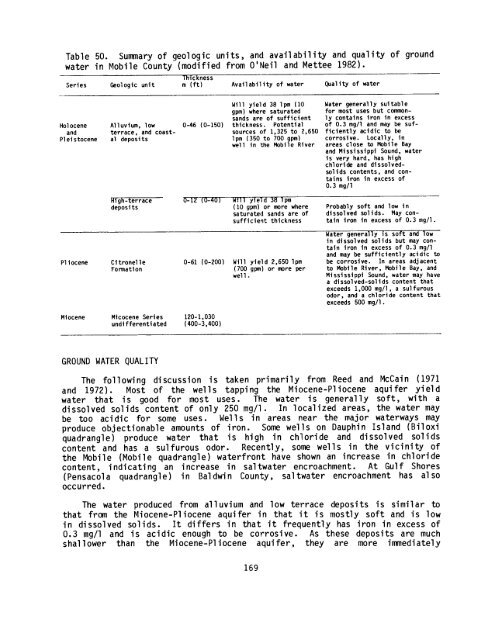ecological characterization atlas of coastal alabama - Data Center
ecological characterization atlas of coastal alabama - Data Center
ecological characterization atlas of coastal alabama - Data Center
You also want an ePaper? Increase the reach of your titles
YUMPU automatically turns print PDFs into web optimized ePapers that Google loves.
Table 50 . Summary <strong>of</strong> geologic units, and availability and quality <strong>of</strong> ground<br />
water in Mobile County (modified from O'Neil and Mettee 1982) .<br />
1hicKness<br />
Series Geologic unit m(ft) Availability <strong>of</strong> water Quality <strong>of</strong> water<br />
Holocene Alluvium, low<br />
and terrace, and coast-<br />
Pleistocene al deposits<br />
Will yield 38 lpm (10<br />
gpm) where saturated<br />
sands are <strong>of</strong> sufficient<br />
0-46 (0-150) thickness . Potential<br />
sources <strong>of</strong> 1,325 to 2,650<br />
lpm (350 to 700 gpm)<br />
well in the Mobile River<br />
Water generally suitable<br />
for most uses but commonly<br />
contains iron in excess<br />
<strong>of</strong> 0 .3 mg/1 and may be sufficiently<br />
acidic to be<br />
corrosive . Locally, in<br />
areas close to Mobile Bay<br />
and Mississippi Sound, water<br />
is very hard, has high<br />
chloride and dissolvedsolids<br />
contents, and contains<br />
iron in excess <strong>of</strong><br />
0 .3 mg/1<br />
tg - errace<br />
deposits<br />
- - y e pm<br />
(10 gpm) or more where Probably s<strong>of</strong>t and low in<br />
saturated sands are <strong>of</strong> dissolved solids . May consufficient<br />
thickness tain iron in excess <strong>of</strong> 0 .3 mg/l .<br />
Water genera y is so t and low<br />
in dissolved solids but may contain<br />
iron in excess <strong>of</strong> 0 .3 mg/l<br />
and may be sufficiently acidic to<br />
Pliocene Citronelle 0-61 (0-200) Will yield 2,650 lpm be corrosive . In areas adjacent<br />
Formation (700 gpm) or more per to Mobile River, Mobile Bay, and<br />
well . Mississippi Sound, water may have<br />
a dissolved-solids content that<br />
exceeds 1,000 mg/l, a sulfurous<br />
odor, and a chloride content that<br />
exceeds 500 mg/1 .<br />
Miocene Micocene Series 120-1,030<br />
undifferentiated (400-3,400)<br />
GROUND WATER<br />
QUALITY<br />
The following discussion is taken primarily from Reed and McCain (1971<br />
and 1972) . Most <strong>of</strong> the wells tapping the Miocene-Pliocene aquifer yield<br />
water that is good for most uses . The water is generally s<strong>of</strong>t, with a<br />
dissolved solids content <strong>of</strong> only 250 mg/l . In localized areas, the water may<br />
be too acidic for some uses . Wells in areas near the major waterways may<br />
produce objectionable amounts <strong>of</strong> iron . Some wells on Dauphin Island (Biloxi<br />
quadrangle) produce water that is high in chloride and dissolved solids<br />
content and has a sulfurous odor . Recently, some wells in the vicinity <strong>of</strong><br />
the Mobile (Mobile quadrangle) waterfront have shown an increase in chloride<br />
content, indicating an increase in saltwater encroachment . At Gulf Shores<br />
(Pensacola quadrangle) in Baldwin County, saltwater encroachment has also<br />
occurred .<br />
The water produced from alluvium and low terrace deposits is similar to<br />
that from the Miocene-Pliocene aquifer in that it is mostly s<strong>of</strong>t and is low<br />
in dissolved solids . It differs in that it frequently has iron in excess <strong>of</strong><br />
0 .3 mg/1 and is acidic enough to be corrosive . As these deposits are much<br />
shallower than the Miocene-Pliocene aquifer, they are more immediately<br />
169
















